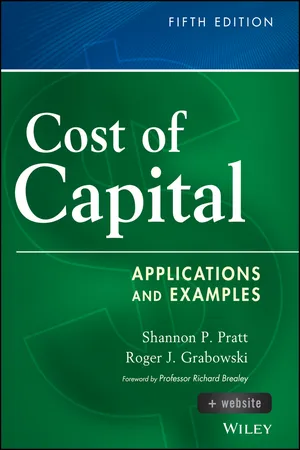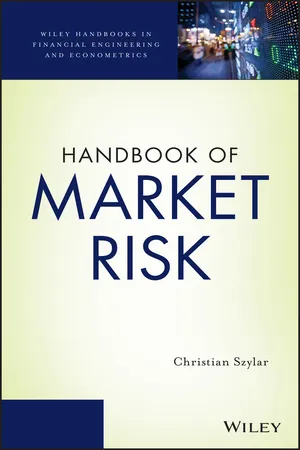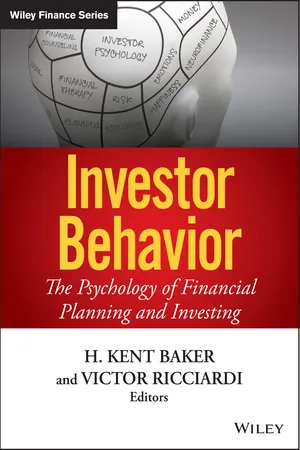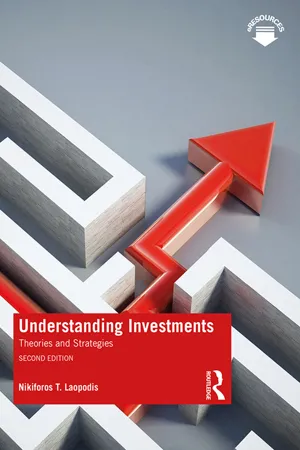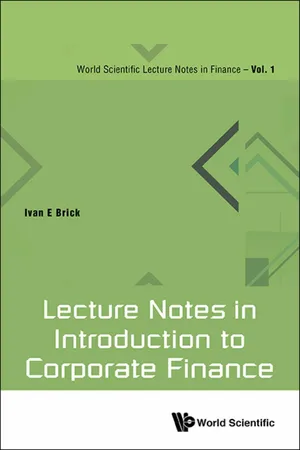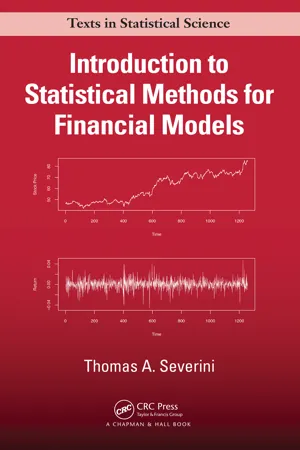Business
CAPM Assumptions
The Capital Asset Pricing Model (CAPM) is based on several key assumptions, including perfect capital markets, investors with homogeneous expectations, no taxes or transaction costs, and unlimited borrowing and lending at the risk-free rate. These assumptions provide the foundation for the model's calculations of expected returns and risk premiums for individual assets within a diversified portfolio.
Written by Perlego with AI-assistance
Related key terms
Related key terms
1 of 4
Related key terms
1 of 3
10 Key excerpts on "CAPM Assumptions"
- eBook - ePub
Cost of Capital
Applications and Examples
- Shannon P. Pratt, Roger J. Grabowski(Authors)
- 2014(Publication Date)
- Wiley(Publisher)
Chapter 10 Capital Asset Pricing Model- Introduction
- Concept of Market or Systematic Risk
- Background of the Capital Asset Pricing Model
- Market (or Systematic) and Unique (or Unsystematic) Risks
- Using Beta to Estimate Expected Rate of Return
- Modifying CAPM
- Firm Size Phenomenon
- Company-specific Risk Factor
- Modified CAPM Cost of Capital Formula
- Examples of a CAPM Model
- Example of CAPM Method Using Morningstar Data
- Example of a CAPM Method Using Duff & Phelps Size Study Data
- Assumptions Underlying the Capital Asset Pricing Model
- Summary
Introduction
The capital asset pricing model (CAPM) has served as the foundation for pricing risk for nearly fifty years. One author has summarized its acceptance this way:Modern academic finance is built on the proposition that markets are fundamentally rational. The foundational model of market rationality is the CAPM. The implications of rejecting market rationality as encapsulated by the CAPM are very considerable. In capturing the idea that markets are inherently rational, the CAPM has made finance an appropriate subject for econometric studies. Industry has come to reply on the CAPM for determining the discount rate for valuing investments within the firm, for valuing the firm itself, and for setting sales prices in the regulation of utilities, as well as for such purposes as benchmarking fund managers and setting executive bonuses linked to adding economic value.1Financial theorists generally have favored using the CAPM as the preferred method to estimate the cost of equity capital, and the CAPM has become the most widely used method for estimating the cost of equity capital.2As with any model, certain assumptions are made in developing CAPM, and those assumptions also represent limitations. Despite its limiting assumptions, CAPM helps explain the relationship of the risk among stocks and their expected returns.Concept of Market or Systematic Risk
The CAPM has many critics. The basic criticisms are not about the theoretical underpinnings of the CAPM. Rather they center on an underlying premise of the CAPM: - eBook - ePub
- (Author)
- 2023(Publication Date)
- Wiley(Publisher)
2 The model provides a linear expected return–beta relationship that precisely determines the expected return given the beta of an asset. In doing so, it makes the transition from total risk to systematic risk, the primary determinant of expected return. Recall the following equation:E(Ri ) = Rf + β i [E(Rm ) – Rf ]The CAPM asserts that the expected returns of assets vary only by their systematic risk as measured by beta. Two assets with the same beta will have the same expected return irrespective of the nature of those assets. Given the relationship between risk and return, all assets are defined only by their beta risk, which we will explain as the assumptions are described.In the remainder of this section, we will examine the assumptions made in arriving at the CAPM and the limitations those assumptions entail. Second, we will implement the CAPM through the security market line to price any portfolio or asset, both efficient and inefficient. Finally, we will discuss ways in which the CAPM can be applied to investments, valuation, and capital budgeting.8.1. Assumptions of the CAPM
Similar to all other models, the CAPM ignores many of the complexities of financial markets by making simplifying assumptions. These assumptions allow us to gain important insights into how assets are priced without complicating the analysis. Once the basic relationships are established, we can relax the assumptions and examine how our insights need to be altered. Some of these assumptions are constraining, whereas others are benign. And other assumptions affect only a particular set of assets or only marginally affect the hypothesized relationships. - eBook - ePub
- Christian Szylar(Author)
- 2013(Publication Date)
- Wiley(Publisher)
hapter FiveThe Capital Asset Pricing Model and the Arbitrage Pricing TheoryEvery model is wrong, but some are useful.—George BoxThe original Capital Asset Pricing Model (CAPM) was derived by Sharpe, Lintner, and Mossin in 1964. We will consider this original model as well as extensions of it in lectures that follow. As with every other model, CAPM requires simplifying assumptions because of the complexity of the real world. There are a number of assumptions underlining the CAPM model, but only three of those are absolutely necessary for deriving the CAPM. The assumptions are as follows:1. One-period investment horizon.2. Rational, risk-averse investors.3. Unlimited borrowing and lending is allowed at a risk-free rate that is the same for all investors.4. There are no taxes.5. There are no transaction costs and inflation.6. All assets are infinitely divisible.7. Free flow and instant availability of information.8. There are many investors on the market.9. All assets are marketable.10. All investors have homogeneous expectations about expected returns, variances, and covariances of assets.Also, we have shown that in the presence of a risk-free asset and under the assumptions that all individuals (i) face the same universe of assets, (ii) have the same investment horizon, and (iii) have the same expectations about future returns, variances, and covariances, and efficient portfolios will be combinations of the tangent portfolio and the risk-free asset.Hence, we can conclude that assumptions 1, 3, and 10 are the most relevant assumptions in deriving CAPM. However, it is obvious that the reality is distorted by making most of the assumptions outlined above. - eBook - ePub
Investor Behavior
The Psychology of Financial Planning and Investing
- H. Kent Baker, Victor Ricciardi(Authors)
- 2014(Publication Date)
- Wiley(Publisher)
From the discussion of optimal portfolio selection, investors have learned that the risk of an asset cannot be evaluated in isolation. Instead, the risk of the asset has to be based on its contribution to the risk of the portfolio. Further, the risk of the asset is defined in relation to the market portfolio. As noted previously, some risks are diversifiable. Other risks are not diversifiable because they affect the entire market, that is, they are systematic risks. Risk-averse investors should only take risk if they are appropriately compensated. In response to the advancements made by early finance researchers, theorists searched for a way to quantify the trade-off between risk and return. They understood that investors would not be compensated for risks they could avoid through diversification by adding diversifiable or unsystematic risk.The result is the capital asset pricing model (CAPM). The CAPM provides a measure of risk of a security called beta (β). Beta quantifies the sensitivity of a security's return to the market. Of course, each asset has its own beta. The beta of the market is 1.0 and the beta of the risk-free asset is zero, as it is, by definition, risk free. Operationally, the beta for an asset is computed by dividing the covariance of the security's return and the market by the variance of market returns.In 1990, William Sharpe received the Nobel Prize in Economics, in part for his work on the trade-off between risk and return. Sharpe (1964) provides a simple, yet powerful model of returns. Equation 2.1 shows the CAPM as:(2.1)so that the expected return for asset i (E (R i )) varies directly with the measure of risk (βi ). R f denotes the risk-free interest rate and E (R m ) is the expected return for the market. Note that the market risk premium (E (R m ) – R f ) must be positive because, if it were not, no investor would invest in risky assets. According to this model, the expected return of the asset increases with increases in risk.Although initial tests show that the CAPM appears to work well (Fama, 1991), later evidence suggests that returns depend on other factors in addition to the market. Theorists proposed alternatives to the CAPM and one example is the three-factor model proposed by Fama and French (1996). The idea is that the CAPM does not pick up other risk factors. For example, Fama and French identify two other factors: firm size and the book-to-market ratio. Fama and French model these factors because evidence indicates that the CAPM apparently does not perform well in explaining the cross-section of returns across stocks. Small firms and those with high book values relative to market values have high returns. As the CAPM, a cornerstone of modern finance, was called into question, another fundamental theory based on the efficiency of financial markets was also revealing evidence of flaws in the academic literature. The following section describes the dominant view of the functioning of markets, the efficient market hypothesis (EMH). - eBook - ePub
- Alan J. Baker(Author)
- 2018(Publication Date)
- Routledge(Publisher)
i . Capital market theory holds that the market offers no premium for risks that the individual investor is perfectly capable of neutralising by his own actions in diversifying his portfolio (recall that we are still assuming that all transactions are costless).10.2 (vi) Qualifications to the Capital Asset Pricing Model
Before we consider the strong implications of the CAPM for capital budgeting by firms, we should be aware of the aspects of the model that may cause us to question its practical relevance. The assumptions in this category are: (1) all investors hold the same expectations about all securities and all correlation coefficients, with information about securities’ prospects being made available simultaneously and at zero cost to all investors; (2) all investors can lend or borrow freely at the same risk-free interest rate; (3) there are no transactions costs; (4) the absence of distorting effects of taxation, whether between dividend income and capital gains or between different groups of investors; (5) all investors are similarly motivated in the general nature of their utility functions and the one-period horizon they all observe in their portfolio decision making.We cannot enter here into the considerable literature devoted to the measurement of capital market efficiency in the sense implied by these assumptions and to establishing the robustness of the CAPM under various types of departure from the ideal. (For a summary of various empirical tests of the CAPM, see Firth, 1977, pp. 96-8; a more detailed analysis of the model and of its statistical testing is contained in Jensen, 1972.) For our purpose it is sufficient to note that the presence of various imperfections may dilute the implications of the CAPM for capital budgeting, and we shall discuss our reservations in that context. - eBook - ePub
Stock Markets, Investments And Corporate Behavior: A Conceptual Framework Of Understanding
A Conceptual Framework of Understanding
- Michael Dempsey(Author)
- 2015(Publication Date)
- ICP(Publisher)
logical determination of a rational shareholder’s long-term expectation of return for the firm (and its investments). We might say that the CAPM fails as a “capital asset pricing model” of markets, but remains as an entirely valid “cost of equity formula” for the firm. This is an important observation. In developing rational models of portfolio allocation (Section C) we shall find that the CAPM appears naturally in the analysis. The principle of the CAPM is not denied. Our point in this chapter is that (for whatever reasons) the CAPM fails abjectly as an explanation of the observed formation of stock returns.Finally, we note that our “non-model” representation of the data has allowed for an interpretation of ex post market premium data, RM− rf, as the component (1) E(RM) − rf— which is to say, investors’ actual anticipated equity premium — in conjunction with the component (2) RM− E(RM) — which provides an estimate of the market’s over/underperformance against actual expectations. Thus, for example, the historical market premium of 8% in Table 2.1 is interpreted as the outcome of investors’ expected risk premium of 6% combined with an outperformance of the market above investor expectations of 2%.1 This chapter develops ideas that were presented in the journal Abacus (Dempsey 2013a, 2013b). I am indeed grateful and indebted to the editors and reviewers of this journal for supporting and publishing this work notwithstanding its unorthodoxy. The above journal issue offers a spirited debate on the CAPM (Abacus - eBook - ePub
- Frank J. Fabozzi, Frank J. Fabozzi(Authors)
- 2012(Publication Date)
- Wiley(Publisher)
CAPM's simplifying assumptions make it easier to deduce properties of market equilibria, which is like computing falling body trajectories while assuming there is no air. But, before betting the ranch that the feather and the brick will hit the ground at the same time, it is best to consider the implications of some of the omitted complexities. The present section mostly explores the implications of generalizing one of the CAPMs' simplifying assumptions.Note the difference between the statement “The market is efficient,” in the sense that market participants have accurate information and use it correctly to their benefit, and the statement “The market portfolio is a mean-variance efficient portfolio.” Under some assumptions the two statements are equivalent. Specifically, if we assume:Assumption 1 . Transaction costs and other illiquidities can be ignored.Assumption 2 . All investors hold mean-variance efficient portfolios.Assumption 3 . All investors hold the same (correct) beliefs about means, variances, and covariances of securities.Assumption 4 . Every investor can lend all she or he has or can borrow all she or he wants at the risk-free interest rate.Then based on these four assumptions we get CAPM Conclusion 1: The market portfolio is a mean-variance efficient portfolio. This CAPM conclusion also follows if Assumption 4 is replaced by the following assumption:Assumption 4 ′. Equation (6 ) is the only constraint on the investor's choice of portfolio.As noted earlier, a negativeXiis interpreted as a short position; but this is clearly a quite unrealistic model of real-world short constraints. Equation (6 ) would permit any investor to deposit $1,000 with a broker, sell short $1,000,000 worth of one security, and buy long $1,001,000 worth of another security.In addition to CAPM Conclusion 1, Assumptions 1 through 4 imply CAPM Conclusion 2: In equilibrium, excess returns are proportional to betas, as in equation (5 - eBook - ePub
Understanding Investments
Theories and Strategies
- Nikiforos T. Laopodis(Author)
- 2020(Publication Date)
- Routledge(Publisher)
In this section, we present and discuss economic equilibria, where the supply of and demand for an asset meet so that the price of the asset does not change. Two market equilibria are the capital asset pricing model (CAPM) and the arbitrage pricing theory (APT). Both provide an economic framework for pricing assets by relating a security’s expected return to a measure of risk for that security that emanates from the market. Thus, expected return is positively related to the level of risk involved. But what is the mathematical relationship between expected return and risk? We begin with the CAPM.8.3.1 The capital asset pricing model
8.3.1.1 SML vs. CML
Let us begin with an important question: if all investors select the optimal risky portfolio, what would be the impact on security expected returns and prices? The answer involves knowledge of how equilibrium prices and expected returns are achieved. We start by recalling the concept of the capital market line (CML) and its relevant equation:E(rp ) =rf + [(E(rm ) - rf )/σm ] • σp (7)This equation suggests that the expected return on an efficient portfolio is composed of the minimum compensation required by the investor, offered by the Treasury bill, plus a risk premium for bearing risk inherent in the portfolio. The magnitude of the risk premium – the market risk premium – is adjusted by the portfolio standard deviation and the current market risk premium per unit of market risk. This relationship depicts market equilibrium, where the quantity of shares demanded by investors just equals the quantity of shares supplied in the market.A related and broader relationship is the security market line (SML), which relates an individual security’s (or a portfolio’s) expected return to the risk-free rate and the relative risk of the security (or portfolio). The SML’s equation is as follows:E(ri ) = rf +βi [(E(rm ) – rf )] (8)As before, the difference between the expected return on the market and the risk-free rate is the market risk premium. In this case, however, the risk premium is adjusted in relative terms through a coefficient known as the beta coefficient. - Ivan E Brick(Author)
- 2017(Publication Date)
- WSPC(Publisher)
Assume homogenous expectations. In other words, assume that every investor has the same set of beliefs and therefore M is the optimal portfolio for all investors. For now, suspend your disbelief and let us understand the full implication of this strange assumption. Now remember, in equilibrium (yes, you have to remember your economics) supply of each security must equal to its demand. So every security offered by firms must be held. Therefore if M is the optimal risky portfolio for all individuals, then every security in the market place must be in M. Well, there is one such security and that is the market portfolio. Oh, by the way in the real world people do not have the same expectations. But if we were to add up everyone’s portfolio holding and average them out, would we not get the market portfolio? So I guess assuming homogenous expectations which leads that people hold the market portfolio is not such a bad assumption!The Capital Asset Pricing Model
To get a mathematical representation of equilibrium requires some fancy math. Let us avoid that and note that according to the three assumptions, all investors will invest in the Treasury security and the market portfolio. This implies that all securities will be compared to two benchmarks, the rate of the return of the Treasury security and the risk-free rate. The Capital Asset Pricing Model (henceforth, CAPM) of Lintner, Sharpe and Mossin is a mathematical representation of the market equilibrium discussed in the previous subsection. According to this modelwhere βI is the beta of security I, and it represents the risk of security I. Note that the expected return of security I is a linear combination of the expected return of the market portfolio, E(RM ), and the riskfree rate. Note that [E(RM ) − RF- Thomas A Severini(Author)
- 2017(Publication Date)
- Chapman and Hall/CRC(Publisher)
Proposition 7.2 may be easily adapted to prove this result.Corollary 7.3. LetR p ∗denote a given portfolio and for any arbitrary asset with return R defineα( R )= E( R )−μ f− β( R )()μ p ∗−μ fwhereandμ p ∗= E(R p ∗)β. Consider the set of assets for which( R )= Cov(∕ VarR ,)R p ∗(R p ∗)α. Then the asset with return( R )= 0R p ∗is in this set and it has the maximum Sharpe ratio among all portfolios formed from assets in this set.7.6 The CAPM without a Risk-Free AssetThe CAPM discussed in this chapter is based on the assumption that all the investors choose a combination of the risk-free asset and a portfolio of risky assets. According to efficient portfolio theory, this portfolio of risky assets is the tangency portfolio for all investors. Thus, the market portfolio is equivalent to the tangency portfolio so that the market portfolio has the properties of the tangency portfolio. It is important to note that the optimality of the tangency portfolio in this context is based on the fact that investors combine their portfolio of risky assets with the risk-free asset.In this section, we consider a version of the CAPM that holds without relying on the existence of a risk-free asset. There are two important implications of this change for the CAPM. The more obvious one is that we cannot include the risk-free rate,μ f
Index pages curate the most relevant extracts from our library of academic textbooks. They’ve been created using an in-house natural language model (NLM), each adding context and meaning to key research topics.
Explore more topic indexes
Explore more topic indexes
1 of 6
Explore more topic indexes
1 of 4
